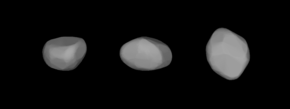208 Lacrimosa
Appearance
 A three-dimensional model of 208 Lacrimosa based on its light curve. | |
| Discovery | |
|---|---|
| Discovered by | Johann Palisa |
| Discovery date | 21 October 1879 |
| Designations | |
| (208) Lacrimosa | |
Named after | Our Lady of Sorrows |
| Main belt (Koronis) | |
| Orbital characteristics[1] | |
| Epoch 31 July 2016 (JD 2457600.5) | |
| Uncertainty parameter 0 | |
| Observation arc | 115.12 yr (42049 d) |
| Aphelion | 2.9309 AU (438.46 Gm) |
| Perihelion | 2.85551 AU (427.178 Gm) |
| 2.89320 AU (432.817 Gm) | |
| Eccentricity | 0.013028 |
| 4.92 yr (1797.5 d) | |
Average orbital speed | 17.51 km/s |
| 209.78° | |
| 0° 12m 1.008s / day | |
| Inclination | 1.7458° |
| 4.2626° | |
| 108.363° | |
| Physical characteristics | |
| Dimensions | 41.33±1.7 km |
| 14.085 h (0.5869 d) | |
| 0.2696±0.023 | |
| S | |
| 8.96 | |
208 Lacrimosa is a main-belt asteroid that was discovered by Austrian astronomer Johann Palisa on October 21, 1879, in Pola. The name derives from Our Lady of Sorrows, a title given to Mary, the mother of Jesus.
10µ radiometric data collected from Kitt Peak in 1975 gave a diameter estimate of 42 km for this asteroid.[2] It is classified as an S-type asteroid and is one of the largest members of the Koronis asteroid family.[3] Hence it is probably a piece of the original asteroid that was shattered in an ancient impact that created the family.
References
- ^ Yeomans, Donald K., "208 Lacrimosa", JPL Small-Body Database Browser, NASA Jet Propulsion Laboratory, retrieved 12 May 2016.
- ^ Morrison, D.; Chapman, C. R. (March 1976), "Radiometric diameters for an additional 22 asteroids", Astrophysical Journal, vol. 204, pp. 934–939, Bibcode:2008mgm..conf.2594S, doi:10.1142/9789812834300_0469.
- ^ Moore, Patrick; Rees, Robin, eds. (2011), Patrick Moore's Data Book of Astronomy (2nd ed.), Cambridge University Press, pp. 164–165.
External links
- The Asteroid Orbital Elements Database
- Minor Planet Discovery Circumstances
- Asteroid Lightcurve Data File
- It is visible at http://www.sky-map.org/ with RA/DEC = 01:12:54 +07:41:56.
- 208 Lacrimosa at the JPL Small-Body Database
